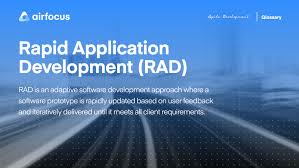RAD Software: Revolutionizing the Development Process
Rapid Application Development (RAD) software has been making waves in the software development industry, offering a faster and more efficient way to create applications. RAD software focuses on prototyping, iterative development, and quick feedback cycles to speed up the development process.
One of the key benefits of RAD software is its ability to reduce the time it takes to develop an application. By allowing developers to quickly create prototypes and iterate on them based on user feedback, RAD software enables faster delivery of high-quality applications.
Another advantage of RAD software is its flexibility. Developers can easily make changes to the application during the development process, leading to a more collaborative and adaptive approach to building software.
Furthermore, RAD software promotes better communication between developers and stakeholders. With its focus on rapid prototyping and iterative development, RAD software encourages constant feedback from users and stakeholders, ensuring that the final product meets their needs and expectations.
In conclusion, RAD software is revolutionizing the development process by offering a faster, more flexible, and collaborative approach to building applications. As technology continues to evolve, RAD software will play an increasingly important role in helping companies deliver innovative solutions in a timely manner.
Top 6 Frequently Asked Questions About RAD Software: Benefits, Tools, and Limitations
- What is RAD software and how does it work?
- What are the advantages of using RAD software in the development process?
- How does RAD software differ from traditional software development methods?
- What are some popular RAD software tools available in the market?
- How can RAD software benefit my organization or project?
- Are there any potential drawbacks or limitations to using RAD software?
What is RAD software and how does it work?
Rapid Application Development (RAD) software is a methodology that focuses on fast prototyping, iterative development, and quick feedback cycles to accelerate the application development process. RAD software allows developers to create prototypes quickly, gather feedback from users and stakeholders, and make iterative improvements based on that feedback. This approach enables a more collaborative and adaptive development process, where changes can be easily incorporated throughout the project lifecycle. Ultimately, RAD software aims to streamline the development process by emphasizing speed, flexibility, and continuous user involvement to deliver high-quality applications efficiently.
What are the advantages of using RAD software in the development process?
When it comes to the advantages of using RAD software in the development process, one key benefit is the significant reduction in development time. RAD software allows for rapid prototyping and iterative development, enabling developers to quickly create and modify applications based on user feedback. This approach not only speeds up the development process but also results in the delivery of high-quality applications in a more efficient manner. Additionally, RAD software promotes flexibility by allowing for easy modifications during the development cycle, fostering a collaborative environment that encourages innovation and adaptation. Overall, the use of RAD software enhances communication between developers and stakeholders, leading to better alignment with user needs and expectations throughout the development process.
How does RAD software differ from traditional software development methods?
Rapid Application Development (RAD) software differs from traditional software development methods in several key ways. Unlike traditional methods that follow a linear and sequential process, RAD software emphasizes iterative development and quick prototyping. This means that RAD software allows for faster feedback cycles, enabling developers to make necessary changes swiftly based on user input. Additionally, RAD software promotes a more collaborative approach between developers and stakeholders, leading to better communication and alignment throughout the development process. Overall, the main distinction lies in RAD software’s ability to accelerate the development timeline, enhance flexibility, and foster a more interactive and adaptive environment compared to traditional methods.
What are some popular RAD software tools available in the market?
When it comes to Rapid Application Development (RAD) software tools, there are several popular options available in the market that cater to the diverse needs of developers. Some widely used RAD software tools include Microsoft PowerApps, OutSystems, Mendix, and WaveMaker. These tools offer features such as drag-and-drop interfaces, pre-built templates, and integrations with various databases and APIs to streamline the development process. Developers can choose the RAD software tool that best suits their project requirements and development preferences to accelerate the application development cycle effectively.
How can RAD software benefit my organization or project?
Rapid Application Development (RAD) software can benefit your organization or project in several ways. Firstly, RAD software allows for quicker development cycles, enabling you to deliver applications faster and more efficiently. This can lead to increased productivity and a competitive edge in the market. Additionally, RAD software promotes collaboration and feedback, ensuring that the final product meets the needs of stakeholders and users. By streamlining the development process and fostering communication, RAD software can help your organization or project achieve its goals more effectively and adapt to changing requirements with greater ease.
Are there any potential drawbacks or limitations to using RAD software?
When considering the use of RAD software, it is important to be aware of potential drawbacks and limitations that may arise. One common concern is the possibility of sacrificing long-term scalability and maintainability for short-term speed. Due to the rapid development nature of RAD software, there may be a risk of creating technical debt if proper care is not taken during the development process. Additionally, the emphasis on quick iterations and prototypes in RAD software may lead to a lack of thorough planning and documentation, which could impact the overall quality and stability of the final product. It is essential for developers to carefully balance the benefits of rapid development with these potential drawbacks to ensure successful outcomes when using RAD software.



